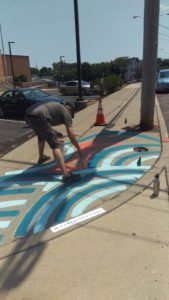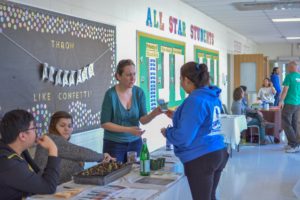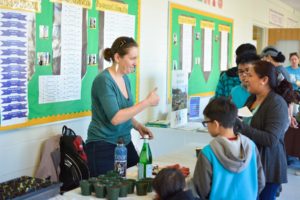Article by Rutgers Raritan Scholar Intern Allie Oross

#lookfortheriver
On Saturday, July 7th, the LRWP led the New Brunswick Environmental Commission and other members of the New Brunswick community in a project on the Redmond Street side of Lord Stirling Elementary School. The final product of their hard work is manifested in a whimsical sidewalk mural that not only serves as a form of neighborhood beautification, but also a semi-permanent reminder of the intricate roles human’s play in the environment.

New Brunswick Environmental Commissioners, residents and LRWP friends paint flowers
Funded through an Americorps alumni grant secured by Thalya Reyes, and designed by former Americorps alum Johnny Malpica, interwoven swirls paint a picture of natural necessities that are integral aspects in every single person’s day to day life. In the mural, clouds create rain drops that collect to form a pulsing river. That river then flows into a set of flowers being pollinated by a bee and a butterfly with the next section displaying a fish in the river. Though the images are depicted in a delightfully playful and abstract manner, each can also be interpreted as a representation for a much more crucial concept:
We, as a community and as a species, must never forget how inextricable we are from the environment. You cannot have one without the other, and though we may seem separated from nature, the gap is almost always smaller than we may think.

New Brunswick Environmental Commissioner Howie Swerdloff paints a river
A few blocks down from the sidewalk mural is the Raritan River. A core purpose for the mural is to act as an expression of the course stormwater runoff takes through the New Brunswick streets every time it rains. After rain events our streets often serve as veins pumping litter and pollution into the heart of our waterways. Out of sight should never mean out of mind when discussing the environment, and the mural engages citizens to remember there is nature all around us if we only make the effort to search for it.
Article by LRWP intern Allie Oross
During the May 21 LRWP meeting, attendees were treated by an insightful and comprehensive presentation on the importance of forage fish and their essential role in a functioning ecosystem. Presenting this information was Zack Greenberg, a Senior Associate of The PEW Charitable Trusts. Zack explained the benefits of using a big picture approach to fishery management and elucidated the different regulatory acts that control the amount of fish being taken out of the water and endeavor to limit the complications of over-fishing.
Zack first provided an overview of The Magnuson-Stevens Act (MSA), the primary law that governs the management of marine fisheries and is responsible for the rebuilding of 43 previously over-fished populations since 2000. Though this law continues to be a significant step towards sustainable management practices, it is constantly targeted by politicians attempting to weaken the guidelines that limit over-fishing and the punitive measures taken when someone violates these guidelines. While the goal of the MSA is to prevent over-fishing while achieving optimum yield, it focuses on individual species and treats their population numbers as mutually exclusive from each other. On the other hand, Ecosystem-based Fisheries Management (EBFM) seeks to remediate this oversight by looking at the different marine species as interlocked pieces in the puzzle that is marine conservation. EBFM seeks to protect the deceptively insignificant forage fish that are actually the foundations for a thriving aquatic habitat. Forage fish include species like salmon, trout, herring, shad, alewives, menhaden, and so on.
By monitoring the fluctuations in population size for different marine species and establishing balance between the different trophic levels in the ocean, a big picture approach emphasizes the interspecies connections that make up an ecosystem. Though these forage fish are small and have little direct market value on their own, they provide an invaluable food source for many of the larger marine species. Removing this resource could have negative implications, not only on the environment, but also on the economy. Taking away the fish that provide nourishment for larger sea life (like marine mammals, sportfish, sharks, seabirds, etc.) can influence recreational activities and the businesses that rely on them. Innumerable coastal and riverine communities (including communities on the Raritan River and Raritan Bay) would lose tourism if they couldn’t provide visitors with opportunities such as fishing, boating, whale watching, and/or diving. The protection of these forage fish is not currently covered under the MSA, which leaves them very vulnerable.
Marine and freshwater ecosystems are connected by much more than just the water that flows between them. Multiple forage fish species, including alewives and herring, are anadromous, meaning they migrate from the sea to freshwater rivers in order to spawn. These same species are also suffering from radically low populations due to marine bycatch, which prevents adults from ever reaching their spawning destinations and successfully propagating the species (Hasselman et al, 2016). Along with the obstacle of bycatch, river damming also frequently impedes many fish from migrating upriver to spawn. Many river-focused attempts at repopulating forage fish species have been relatively unsuccessful due to the marine based causes of population decline (bycatch, over-fishing, habitat degradation, etc.) (West, 2017). With improved federal fishery management and strengthened marine conservation policies we can negate the damage we have inflicted not only on individual species but on the environment as a whole.
The Pew Charitable Trusts, the LRWP and other environmental groups that understand the tremendous value of the “small fish” encourage the public to stand up on the issue of declining forage fish populations. The public has until June 25 at 5 PM to provide comment to the New England Fishery Management Council on a “control rule” for Atlantic Herring fishing in New England. Pew is rallying signatures/letters in support of the Council creating a 50-mile coastal buffer from herring trawling and implementing a science-based control rule. Please consider signing Pew’s Action Alert, or send an email to the New England Fisheries Management Council to let them know that you care about New England’s coastal ecosystem and economy, and that you want them to extend a buffer zone to 50 miles offshore year-round in which midwater trawl fishing would not be allowed to operate.
Referenced Articles
- Hasselman, D. J., Anderson, E. C., Argo, E. E., Bethoney, N. D., Gephard, S. R., Post, D. M., Palkovacs, E. P. (2016). Genetic stock composition of marine bycatch reveals disproportional impacts on depleted river herring genetic stocks. Canadian Journal of Fisheries and Aquatic Sciences, 73(6), 951-963. doi:10.1139/cjfas-2015-0402
- West, A. (2017-2018). Forcing Evolution’s Hand. Inquiry Magazine, 29-32. https://officeofresearch.ucsc.edu/ord/outreach/inquiry.html
Article by Allie Oross, photos by Johnny Malpica

Rutgers Raritan Scholars Interns Justin So and Allie Oross join New Brunswick Environmental Commission Chair Erin Connolly to hand out milkweed seeds at the New Brunswick Food Forum
On a bright morning at 10 AM in the hallways of A. Chester Redshaw Elementary School, tables from multiple community groups lined the halls in anticipation of the 7th Annual New Brunswick Food Forum organized by the New Brunswick Community Food Alliance (NBCFA). Most of the interest groups were related to food and health within the local community and, as the first visitors started to file in, it was evident that these were topics of both concern and interest. Soon the hallways were bustling with adults and children alike from the surrounding neighborhoods.
The Lower Raritan Watershed Partnership (LRWP) table was promoting the importance of pollinator plants (plants that attract pollinator species) as we handed out milkweed seeds and vegetable seedlings. Children could choose to plant their own milkweed seed at one of our tables and many of them enjoyed the opportunity to get their hands dirty.
Pollinators are animals that assist in the fertilization of plants by transferring pollen from the male anatomy of the flower to the female parts. Pollinators can include bees, butterflies, bats, and birds and are essential for plant biodiversity. The number of pollinators in an area has a direct and positive correlation with the general health of an ecosystem. When these biotic vectors rifle around within the flower looking for nectar, pollen gets stuck to their legs or bodies and when they go to the next flower they take that pollen with them. This allows for diverse genotypes within plant populations that would not be seen without the assistance from pollinators.
The LRWP’s goal in handing out milkweed was not only to encourage an increase in pollinator populations in our urban community, but to also increase public awareness and involvement. We asked that people tend to their milkweed plant and watch it grow for two months, then join us and the New Brunswick Environmental Commission for a “pollinator planting day” on Sunday June 17. At that time the plan is to plant the milkweed seedlings and other pollinator plants in New Brunswick’s Buccleuch Park Pollinator Garden. Though most of the people who visited our table were initially unsure what a pollinator was, many took an interest in the health of our environment and were enthusiastic about the prospect of taking an active role in its prospective remediation.
The ability of our environment to efficiently and cohesively function is of drastic importance to every single person that lives within it. Conveniently enough, that same environmental ability depends mostly on the decisions made and actions taken by our very own species.
As Earth day rolls around, it is vital that we reflect on anthropogenic interference in nature and take responsibility for the consequences of over-development and urbanization. If most of the damage to the planet is caused by humans, then it is a logical conclusion that humans also possess the solution. Events like the Food Forum that engage community education and interaction are integral for the remediation of our planet and decreasing the prevalence of apathy and ignorance within our population.






